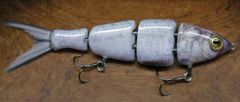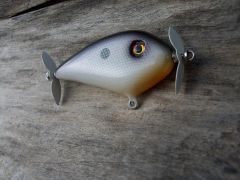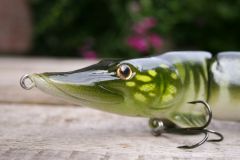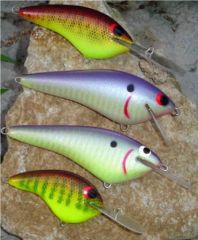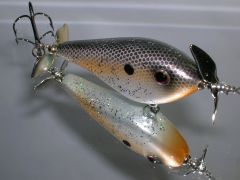-
Posts
1,752 -
Joined
-
Last visited
-
Days Won
1
Content Type
Profiles
Articles
TU Classifieds
Glossary
Website Links
Forums
Gallery
Store
Everything posted by Lure--Prof
-
Hey, I just saw these David!! I miss looking at the gallery for a week, a few guys post 9000 pics of repaints, or 14 views of the same lure, (I keep hearing these comments from some friends, don't kill the messenger!) and the next thing you know, is that these beautifully engineered babies are on page eleventy-five! Point being, is that I need to check the gallery more often, along with some other guys too busy to keep up. I can't wait to mug the guy or guys who now own them and save them from having to lug these around...and if one person has more than one of these, that's not even fair! How are the rest of us poor slobs supposed to get hold of any when other people keep cornering the market! I'll bet you can't even keep any for yourself!! Nice baits! So...do you really think that 1/8 polycarbonate is better for the tails than 1/16th???? Dino
-
-
Yup, if I know anything at all, I know that you're not going to last very long making fishing lures without a sense of humor! Dean
-
I polish lips regularly, a practice which started when I learned the necessity of maintaining smooth edges on all crankbait bills to avoid cutting my line (not necessarily light line either!) on hard fighting fish. Of course as a crankbait builder who often built/modified lips from scratch, one thing led to another... Micro-mesh is a name you need to know---they make fine to ultra-fine sanding products, which I never fail to use when polishing polycarbonate. They sell polishing kits, with instructionson how to achieve scratch free results on various surfaces. You can use their products by themselves, or in conjunction with rotary tools, compounds, and various plastic, or some metal polishes to get perfect results, or any degree of polishing you deem necessary. I sometimes will thin thicker lips on a sander, and then polish them out, and don't consider it to be a terribly difficult task. It simply requires the right tools, and some elbow grease. Perhaps the trickiest part with rotary tools is learning not to make too much heat and burn the surface. Practice is the key. I often use a felt flap wheel in my dremel for a finish polish after using micro-mesh up to 6000 grit for a fairly quick smooth finish. My friend John Pearson (nugene on TU) mentioned to me recently using the old standby metal polishing cream, Simicrome, and a cotton cloth for quickly removing some fine scratches also. I'd like to experiment with a slow-turning buffer--common grinders with buffing wheels generate too much heat too quickly with their high speeds to be much use, unless proceeding very very carefully! MicroMesh products are available through some hobby stores, and stores specializing in wood-finishing products. Various metal and plastic poishes, headlight lens restoration kits, along with sandpaper up to 2000 grit, are available in auto parts stores. Your search-engine's your friend too. Dean
-
Lots of great advice here. The great thing about Createx is that I never have to thin any of it. Like Kingfisher said, "Shake the crap out of it!" I also place a small square of panty-hose between the bottle and top, as a filter. I also change it on a semi-regular basis and wash the caps. After more painting experience you'll learn what your painted lure needs to look like, in order for it to turn out like you want after it is clearcoated. For awhile this requires some trial and error, and no small amount of faith! Dean
-
What Mercury said is true. I too have a moisture trap at the tank, but I'm still always working around both line moisture, and leftover water from cleaning between colors. No matter how much I shake out my brush and blow air after cleaning, I nearly always 1st blow out a little moisture from my cup on my gravity-fed Eclipse if I wait 15 minutes or so before getting around to the next color. 15 psi can still be too much pressure if you're a little too close, and it takes very little moisture to mess things up this close. I use a lot of stencils in order to maintain a bit more pressure most of the time, but I do drop down low and do some close-up and fine detail work sometimes, such as increasing the size of Tater-Hog's tiny shad dots () or doing fine-line stuff on the gill-plates, and in order to be smooth you really have to turn the pressure way down! Note that most of the litttle compressors which fingernail pros use are almost tiny, and seldom make more than 15 psi max. I do fine detail with the colors you mentioned, as do other painters I know, and making these paints thicker would just make them more difficult to spray at the low psi's necessary to do the fine stuff. In fact to do a lot of super-fine detail it would be simpler to switch to a thinner type paint than regular Createx. Your answer lies somewhere in our discussion, I promise. You can research "spiderwebbing problems" through myriad airbrushing websites, and you'll find that thickening RTU Createx is never a possible solution. Eventually I'll get around to adding a quality moisture trap right at my airbrush, and would have done so already if I was trying to shoot anything other than water-base acrylics. I will add that every drop of paint I shoot is thoroughly shaken, and strained through panty-hose. (insert punchline here) Good luck, hang in there! Dean
-
This indicates a problem...I've never encountered any Createx that is too thin too spray...and I've encountered a lot of it! Do you shake it THOROUGHLY before using? Why do you think it is too thin? If it is running on you, You are spraying too close, or too long in one spot, or either of these with too much air pressure. If you are trying to achieve close, detailed, spraying, the paint has to be fairly thin (normal Createx), and the air pressure has to be low, for the most part. I assume you're not getting condensation in your line and spitting some water along with your paint. Dean
-
Yes, fats, outside of some commercially made plastics and spoons, it's handmade, or re-made all the way for me, if not by me, then someone I know! Dean
-
-
Fishwhittler is 100% correct about Polycrylic's unsuitablity as a clear coat. Many lacquers today, in contrast with a very few years ago, are non-yellowing. Ace Hardware sells a good non-yellowing lacquer, and if they don't have it in stock, they will order it for you. Every clearcoat has its advocates and detractors, its pluses and minuses, and its own particular learning curve. There is no small amount of info on all of them here that can be obtained with a bit of digging. Dean
-
one more time... What BobP said. I've used a little bit of everything, including the various mylars to the various kitchen foils, but Britebak www.venturetape.com is my go-to tape. It's available in gold too! Dean
-
I've used similar from potato chip bags and various candy wrappers. Some of it could not be textured, and some very little, using it by itself by spraying 3M Super 77 Spray Adhesive on the back, as opposed to the way Mavrick did his, which allowed him to texture his much more easily. I clearcoat with Dicknite's Topcoat, but over foil it is necessary to coat the foil with epoxy first, then paint (& heatset Createx), then clearcoat with Dicknite's. Whie I got some flashy colors by doing this, I find that it's easier to use my standard thin silver or gold foiling tape, texturing it the way I want, and then painting it with transparent colors. Dean
-
Big clue right there! Simply because spray cans are from the same manufacturer does not mean they're compatible. In fact, I'd guess that there are incompatible paints somewhere in the product lines of every brand, although you will find some consistancy between similar paints of a single brand. Metallic paints will likely be compatible with other metallic paints of the same brand, but probably not with the standard color line; and unfortunately, most labels and ingredient listings will still leave you in the dark---Many people assume that enamel means that it is an oil base product, but this is not true, just as acrylic can be a water base paint, but doesn't have to be, even though a water-based paint will be an acrylic. Paint & color compatibility is a big advantage of an airbrush paint system, along with pressure control, which gives you accuracy, producing overspray(odor & mess) control, and eventually, economy. Of course you'll also be able to take advantage of much greater color selection too! If you've already learned to paint via the rattle-cans (sure sounds like you have), switching to an airbrush system will make every aspect of your painting easier, and more fun! Dean
-
I don't know about Future in 2009, but several years ago I used several different J&J commercial floor sealers and finishes, and they all yellowed slightly after about a year---and this is with little to no sunlight exposure. I seal all my balsa lures with epoxy, usually Envirotex Lite, prior to painting with Createx. Besides adding strength to the bait, it also insures that I can really pour the heat to it when I heat-set it, without causing any blistering or blemishes of any kind. I've been using Dicknite's topcoat for 3 years now over Createx, and never knew what this paint-wrinkling looked like until a friend sent me a lure he'd done without adequately heatsetting it. He figured out his mistake after that first ruined bait. I also do as Mark mentioned with my Sharpie signatures, BTW. Createx and Parma are the only paints (basically the same thing) I use, and Dicknite's is the only clearcoat (I brush it on), and I have zero problems. I am very happy with my lures, and I am very particular when it comes to my tackle. Dean
-
-
Thanks Steve for the info!! Dean
-
-
-
I've been using Dicknite's Topcoat, a solvent-catalyzed moisture-cure urethane, for a little over 3 years now, and having learned its particulars, I am quite happy with it, as are several of my friends. David Sullivan (CaptSully_18 here) and I get together on an irregular basis, and we always discuss clearcoats, which in our case means something like, "If everyone would just put a little effort into learning to brush on Dicknite's, there would be a whole lot less disccussion of clearcoats on TU". We consider it to be much easier to use than epoxies, with much better results, including clarity and durability; but most people begin with epoxies, and urethanes are simply a different product, and do not handle, apply, cure, or store, like the epoxies most people begin with when starting to clearcoat their lures. Dean
-
Also...be sure and heat-set your baits when you use Createx! This is absolutely necessary!! I use a hair dryer on high on each bait for several minutes on each lure after completing painting, and also use it between coats to a lesser extent, depending on the thickness of the coat. Without this step, my baits would be a mess when using a solvent-containing topcoat (Dicknite's). Thorough heat-setting however, transforms Createx, enabling me to use Dicknite's for the last 3 years without a problem. I primarily paint epoxy-sealed wood baits, so pouring the heat to them is no problem. I'm a little more cautious with plastic bodies though. I've never had a problem with Norman's Deep Little N's, Rebel Pop R's, or Heddon's Spooks, along with some others. However, I recently had an inexpensive BPS lure deform, so you are so advised. Dean
-
Each of you, THANK YOU for the kind words, they mean a lot to me; I try to put a lifetime of fishing into each lure. The top and bottom lures are staying in my tackle box, and the middle two have been spoken for. I threw all 4 yesterday: I fished the top one through as far as we could tell, a non-feeding period (sometimes it is difficult to tell on a hard pounded, sparsley-populated bass lake!). After Larry caught a single keeper fish in the first 4 hours we took a short rain-break at the dock and got back to cranking. I hit a keeper fish soon after on the bottom lure, and then two more shortly thereafter from the back of the boat, while Larry picked up one from the front, and then another on the next bank, which was big fish of the day, close to 4 pounds. After another location change, he picked up another fat 15 incher. Around sundown at our last spot I threw the fat bait, 2nd from top, a few times, and had one wack it while working on top just as I jerked it---I felt a tick and she left a huge swirl, but no connection, and that was our day, a total of 7--no non-keepers. I threw the Big Shad, 3rd from the top, just a few times to see how it tracked...perfectly, without any tuning. I also noticed, that there were no finish flaws anywhere on the bait, which is rare (at least for me!) with several coats of paint and 4 coats of finish, to not get a dust speck, or small paint miscue, or small bubble. Today is back-recovery day, and lip-finishing day, after flinging at those mean post-spawners for several hours yesterday...Thanks again everyone! Dean
-
-
You must be able to turn it for several hours, so a relatively dust free environment is a plus. E-tex also must measured precisely and mixed thoroughly! Its advantages as a clear coat are a long pot life, and it retains a bit more flex than most epoxies so you have less problem with impact cracking. I use it for sealing crankbaits. Do not try to use an extra-thick coat in an effort to keep it from pulling away from edges, as this will only cause sagging you'll have to sand.
-
BobP is correct enough--Full cure is actually a month, but if you didn't know better, you'd think it was about 2 days. I sometimes use some baits after a few days, but I always know that if I use one hard, and can feel a little Gamakatsu or Owner hook rash, (from unteed hooks) that I can come home and apply another coat. After curing for a month, you'll notice the difference in the hardness and scratch resistance, but lots and lots of bass teeth will eventually leave some light scratches. I caught a lot of nice fish on one lure last fall, and renewed it with one normal coat, not that it was necessary, but just because I could. BTW, I use 4 coats, brushing them on a day apart although recoating can be done faster. Brushing it normally results in a thinner coat than dipping. I also keep my Dicknite's water thin by using Bloxygen to replace the air in any container after use and then reseal the container airtight. I have complete confidence in selling a bait coated with Dicknite's topcoat, because I know how it performs. Dean
-




